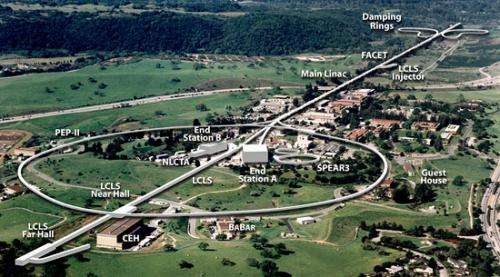September 12, 2012 report
Researchers at SLAC find too many taus decay from bottom quarks to fit Standard Model

(Phys.org)—In a reminder that not all important physics work is going on at CERN, researchers at the Stanford Linear Accelerator Center (SLAC) have been sending positrons and electrons into storage rings left over from its now non-operational particle accelerator and have found, as they describe in their paper published in the journal Physical Review Letters, that the amount of taus produced as bottom (b) quarks decay, is more than has been predicated by the Standard Model, and indicates problems with the supersymmetry (SUSY) theory as well.
The Standard Model is a general theory that was created over several decades and finalized in the 1970's to describe everything that exists, i.e. all known matter, and how it all works together. Unfortunately new science has been poking holes in much of it over the past several years, which has led to new theories such as SUSY. This new research further degrades the usefulness of the Standard Model and even casts doubt on SUSY.
In their experiments, the researchers at Stanford have been causing positrons and electrons to collide at the point of their BaBar detector. As the collisions occur and the particles are knocked apart B mesons (hadrons that are made of two quarks) are produced. But they don't last long, they decay into D or D* mesons, charged leptons, or neutrinos. In this case, the team focused on the mesons, which are further classified as either muons or taus. Muons are generally produced in abundance in such collisions, whereas taus are rare, and it's the amount of them that were produced in the collisions at SLAC that has cast doubts on the Standard Model. Instead of the 20% frequency rate predicted for D mesons, the researchers found a 31% rate (and a 25% rate for D* mesons instead of the predicted 23%). These differences are also significant enough to cause pretty serious problems for SUSY.
To explain the differences between the theories and observed results the researchers suggest that perhaps another Higgs Boson is at work; SUSY suggests there may be as many as four, though research at CERN is still ongoing to prove that what was observed earlier this year was in fact an actual Higgs.
In any case, this new research shows that there is still work to be done regarding coming up with a theory that truly does encompass all matter, anti-matter, dark matter, etc. before any consensus can be reached.
More information: Evidence for an Excess of B̅ →D(*)τ-v— τ Decays, Phys. Rev. Lett. 109, 101802 (2012) DOI:10.1103/PhysRevLett.109.101802
Abstract
Based on the full BABAR data sample, we report improved measurements of the ratios R(D(*))=B(B̅ →D(*)τ-v— τ)/B(B̅ →D(*)ℓℓ-v— ℓ), where ℓ is either e or μ. These ratios are sensitive to new physics contributions in the form of a charged Higgs boson. We measure R(D)=0.440±0.058±0.042 and R(D*)=0.332±0.024±0.018, which exceed the standard model expectations by 2.0σ and 2.7σ, respectively. Taken together, our results disagree with these expectations at the 3.4σ level. This excess cannot be explained by a charged Higgs boson in the type II two-Higgs-doublet model.
via Physics Synopsis
Journal information: Physical Review Letters
© 2012 Phys.org
















